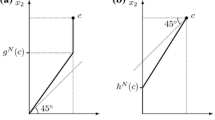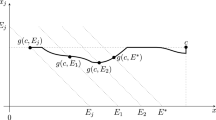Abstract
For the problem of adjudicating conflicting claims, a rule is consistent if the choice it makes for each problem is always in agreement with the choice it makes for each “reduced problem” obtained by imagining that some claimants leave with their awards and reassessing the situation from the viewpoint of the remaining claimants. We develop a general technique to determine whether a given two-claimant rule admits a consistent extension to general populations, and to identify this extension if it exists. We apply the technique to a succession of examples.
Similar content being viewed by others
References
Aumann R, Maschler M (1985) Game theoretic analysis of a bankruptcy problem from the Talmud. J Econ Theory 36:195–213
Balinski M, Young P (1982) Fair representation. Yale University Press, New Haven
Chambers C, Thomson W (2002) Group order preservation and the proportional rule for bankruptcy problems. Math Soc Sci 44:235–252
Chun Y (1999) Equivalence of axioms for bankruptcy problems. Int J Game Theory 28:511–520
Dagan N (1996) New characterizations of old bankruptcy rules. Soc Choice Welf 13:51–59
Dagan N, Volij O (1997) Bilateral comparisons and consistent fair division rules in the context of bankruptcy problems. Int J Game Theory 26:11–25
Davis M, Maschler M (1965) The kernel of a cooperative game. Nav Res Logist Q 12:223–259
Dominguez D, Thomson W (2006) A new solution to the problem of adjudicating conflicting claims. Econ Theory 28:283–307
Hokari T, Thomson W (2000) On properties of division rules lifted by bilateral consistency, mimeo
Hokari T, Thomson W (2003) Bankruptcy problems and weighted Talmud rules. Econ Theory 21:241–261
Kaminski M (2000) Hydraulic rationing. Math Soc Sci 40:131–155
Kaminski M (2006) Parametric rationing methods. Games Econ Behav 54:115–133
Lensberg T (1988) Stability and the Nash solution. J Econ Theory 45:330–341
Maschler M, Owen G (1989) The consistent Shapley value for hyperplane games. Int J Game Theory 18:389–407
Moulin H (2000) Priority rules and other asymmetric rationing methods. Econometrica 68:643–684
O’Neill B (1982) A problem of rights arbitration from the Talmud. Math Soc Sci 2:345–371
Peleg B (1985) An axiomatization of the core of cooperative games without side-payments. J Math Econ 14:203–214
Sasaki H, Toda M (1992) Consistency and characterization of the core of two-sided matching problems. J Econ Theory 56:218–227
Schummer J, Thomson W (1997) Two derivations of the uniform rule. Econ Lett 55:333–337
Tadenuma K, Thomson W (1991) No-envy and consistency in economies with indivisible goods. Econometrica 59:1755–1767
Thomson W (1988) A study of choice correspondences in economies with a variable number of agents. J Econ Theory 46:247–259
Thomson W (1994) Consistent extensions. Math Soc Sci 28:35–49
Thomson W (2001) A characterization of a family of rules for the resolution of conflicting claims, mimeo, revised 2006
Thomson W (2002) Two families of rules for the adjudication of conflicting claims, mimeo
Thomson W (2003) Axiomatic and strategic analysis of bankruptcy and taxation problems: a survey. Math Soc Sci 45:249–297
Thomson W (2006) Consistent allocation rules, mimeo
Thomson W (2007) The claims-truncated proportional rule has no consistent extension: a geometric proof. Econ Lett (forthcoming)
Thomson W, Lensberg T (1989) The axiomatic theory of bargaining with a variable number of agents. Cambridge University Press, Cambridge
Thomson W, Myerson RB (1980) Monotonicity and independence axioms. Int J Game Theory 9:37–49
Thomson W, Yeh C-H (2001) Minimal rights, maximal claims, duality and convexity for division rules, mimeo, revised 2003
Young P (1987) On dividing an amount according to individual claims or liabilities. Math Oper Res 12: 398–414
Author information
Authors and Affiliations
Corresponding author
Additional information
I gratefully acknowledge support from NSF under grant SBR-9731431 and SES 0214691, and the comments of Carmen Bevia, Rodrigo Velez, Chun-Hsien Yeh, and a referee.
Rights and permissions
About this article
Cite this article
Thomson, W. On the existence of consistent rules to adjudicate conflicting claims: a constructive geometric approach. Rev. Econ. Design 11, 225–251 (2007). https://doi.org/10.1007/s10058-007-0027-2
Received:
Accepted:
Published:
Issue Date:
DOI: https://doi.org/10.1007/s10058-007-0027-2
Keywords
- Claims problems
- Consistent extensions
- Proportional rule
- Constrained equal awards rule
- Constrained equal losses rule




